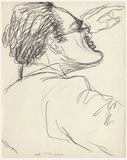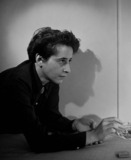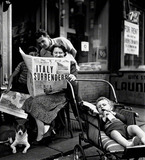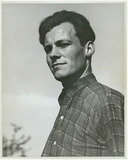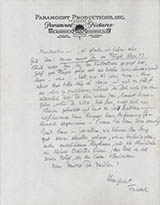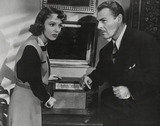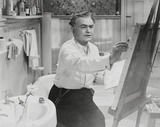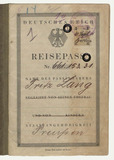Fred Dolbin: Zeichnung von Otto Klemperer (vermutlich 1935)
Illustrator and journalist Benedikt Fred Dolbin was already interested in music in his youth. For a concert by Otto Klemperer, who as conducting Alban Berg’s 1935 Lulu Suite in New York’s Carnegie Hall, he requested press tickets and later reported enthusiastically on the singer Lotte Lehmann, who made “unity of sound, word and meaning” a reality.
Fred Stein: Hannah Arendt, photograph (1944)
Philosopher in a contemplative poseFred Stein photographed the philosopher Hannah Arendt several times between 1941 and 1966. After fleeing the Nazis Arendt lived for some time in Paris. In 1941 she emigrated with her second husband, Heinrich Blücher and her mother to New York.
Fred Stein: Italy surrenders, photograph (1943)
An image of war from New YorkThe image Italy surrenders is one of Fred Stein's most famous street scenes from New York. It shows a portrait of a family reading the newspaper.
Fred Stein: Willy Brandt as a correspondent in Spain (1937)
Willy Brandt and Fred Stein were both members of the Socialist Workers' Party of Germany (SAPD) and met during Stein's years in exile in Paris. This encounter turned into a life-long friendship, which is also reflected in a few portrait shots. In 1937, Stein took photographs of the future leader of the Social Democratic Party of Germany and chancellor in Barcelona.
Frederick Kohner: Draft screenplay Burning Secret (1938)
The melancholy of farewells was the underlying tone of Brennendes Geheimnis in 1933, a film version of Stefan Zweig’s novella of the same name. Frederick Kohner had written the script and the film was directed by director Robert Siodmak.
Friedrich Hollaender: Letter to Marlene Dietrich (undated)
The first collaboration between Friedrich Hollaender and Marlene Dietrich had already shown what a good team the two made: The Blue Angel (Der Blaue Engel - 1930), was an international success for both the actress and the composer. Dietrich subsequently moved to Hollywood, Hollaender became a busy film composer.
Fritz Lang and Bertolt Brecht: Hangmen Also Die (1943)
The anti-Nazi film Hangmen Also Die was made in Hollywood in 1943 as a collaboration between Fritz Lang and Bertolt Brecht. Since the 1973 publication of Brecht’s Journals written in the forties, attention has not only focused on the film, but also on the relationship between the two artists.
Fritz Lang: The Film Noir Scarlet Street (1945)
Scarlet Street (1945), after The Woman in the Window (1944), was Fritz Lang’s second film in his so-called “Black Series”. Once more it was Edward G.
Fritz Lang’s Passport (1931)
Joseph Goebbels is said to have admired him for his two-part silent film The Nibelungs (1924) and Metropolis (1926), while his legendary work M (1931) has been voted by film historians as the most important German film of all time. Fritz Lang was unquestionably among the most notable and influential filmmakers in Weimar Republic Germany.
Fritz von Unruh in Frankfurt’s St. Paul's Church, photograph from von Kurt Röhrig (1948)
This photograph taken by Kurt Röhrig shows the author Fritz von Unruh on 18 May 1948 during his commemorative address to mark the reopening of Frankfurt’s St. Paul’s Church after its destruction in the Second World War.
